The Mourne Mountains and the Ring of Gullion Region is among one of Northern Ireland's most breathtaking landscapes. Visitors can marvel at ring dykes, rugged hills, woodland areas, and fields patterned with small farms.
Recently, these natural wonders have been further enhanced by the addition of public art installations created by talented sculptors and artists. These pieces are strategically placed both in popular areas and off-the-beaten-track locations, offering a unique way to explore and appreciate the region. This artistic integration provides a fresh perspective on the area's rich heritage and stories, making for a creative and memorable experience. Whether you're navigating the well-trodden paths or discovering hidden gems, the fusion of natural beauty and artistic expression in the Mourne Mountains and the Ring of Gullion offers a multifaceted adventure for all visitors.
Ardglass
Overlooking Harbour in Quay Street - `Ocean's Edge'
This piece by Chris Wilson, intends to honour the hard won fruits of the sea and aims to capture the drama and challenge of landing fish in this important regional fishing port. The representation of the fish is literal, reflecting the species caught locally but also symbolising the diminishing stocks to be fished.
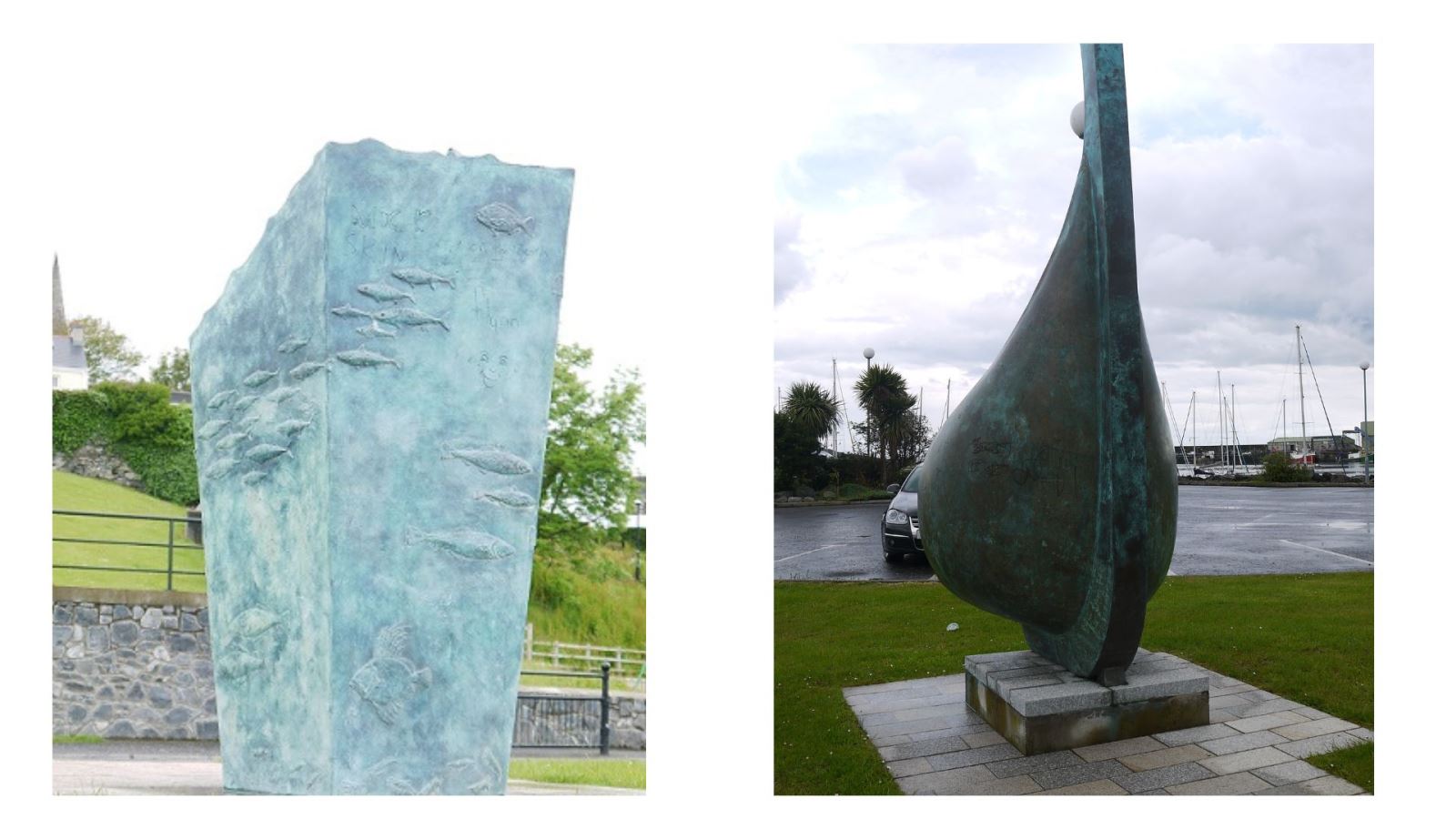
Phennick Cove - `Bronze Vessell'
Alan Burke’s bow of a medieval fishing boat relates to Ardglass as an ancient site with a pre-Christian history suggesting Bronze age. Its establishment as a recognised trading centre pre-dates other major settlements, including Belfast. One of the earliest maps of Ireland on display at the British Library has two key centres marked on the eastern coast - Dublin and Ardglass
Bessbrook
Bessbrook Pond, Co Armagh - `The Flax Flower'
Glimpses of the tranquil millpond in Bessbrook village are lit by the electric blue and silver of the statuesque flax flower, telling the story of the linen industry in the area.
Castlewellan
Castlewellan (Upper Square) -`Square Days and Fair Days'
This artwork celebrates the history of Castlewellan as a centre of markets and hiring fairs as well as the town's strong association with traditional music. It depicts a parade of animals and produce led by a fiddler and a dancing girl "to market to market to buy a fat pig home again, home again, jiggidy jig". The sow is taken from the famous photograph of the "Old Ulster Pig" in Castlewellan Fair.
.jpg)
Newcastle
As part of the overall regeneration of Newcastle, a number of innovative pieces of public art have been installed.
`Cone of Light' - The void or light slit in the sculpture is sighted off the highest point of Slieve Donard overlooking Newcastle and connecting the mountain to the sea.
`Tails of Flight' - This was inspired by the famous Harry Ferguson and his pioneering flight along the Newcastle seafront in 1910. It captures the spirit of that flight but also the feeling of fish tails, which adds a maritime twist.
`Percy French' Statue recognises the work of Percy French who immortalised Newcastle in his famous song "The Mountains of Mourne".
`Global Journeys' - The sculpture was designed to fully integrate with its location by reflecting the changing light conditions of the sky and the surrounding sea and mountains. The title refers to the journeys of visitors to Newcastle and also the yearly migrations of salmon as they return to the Shimna River, which flows through the centre of the town.
.jpg)
Newcastle Roundaout, Dundrum Road - “Words in the Wind”
Situated at the roundabout entrance to Newcastle town on Dundrum Road, this piece, a 12m high kinetic sculpture, by Canadian sculptor, Ron Baird, makes an impressive statement at the entry point to the town. .jpg)
It reflects the natural landscape and the cultural landscape in terms of people, language and song. It literally is powered by the wind, creating movement and interest and the petals are engraved with Celtic and Neolithic drawings. Elegant and simple in form, it suggests both the rugged nature of the Mournes and the fragility of the flora and fauna of this special place. It also is reminiscent of hand held windmills which are still a favourite children’s seaside toy.
Bloody Bridge, Newcastle - `The Smugglers Head' Artist Ralf Sander
This sculpture consists of two columns which are similar to the wind and water shaped rocks of the coastal area at the Bloody Bridge. The`Smugglers Head' refers to the age-old custom of smuggling, which was synonymous with this part of the coastline. Focus closely on the gap and, from the correct angle, the outline of the smuggler’s head becomes visible. The concept behind the piece is that a smuggler must be almost invisible and that he must almost become part of the landscape if he is to go un-noticed.
.jpg)
Trassey Car Park, Bryansford - "Hidden Treasures"
“Hidden Treasures” relates to aspects of the Mourne area flora and fauna which are hidden within the landscape as represented by the cut Mourne granite sections. The horizon lines of the cut stone echo the surrounding landscape and through the window one can see images of the Irish Hare, the peregrine falcon and the Starry Saxifrage
Ballynahinch
The Square - "Ballynahinch Bells"
The sculptures in Ballynahinch's Market Square have been inspired by the town's bells, whether ringing to permit stall holders to start trading or to summon people to church. Within each bell there are symbols of the town's story from its early days as a crossroads to the fashionable hunt balls at Montalto House.
Clough
Clough Roundabout (at junction of A7, A24 and A25) - `On the way to the fair'
This feature greets motorists as they pass through the village and depicts a cow being led by a farmer and represents the village's farming history.
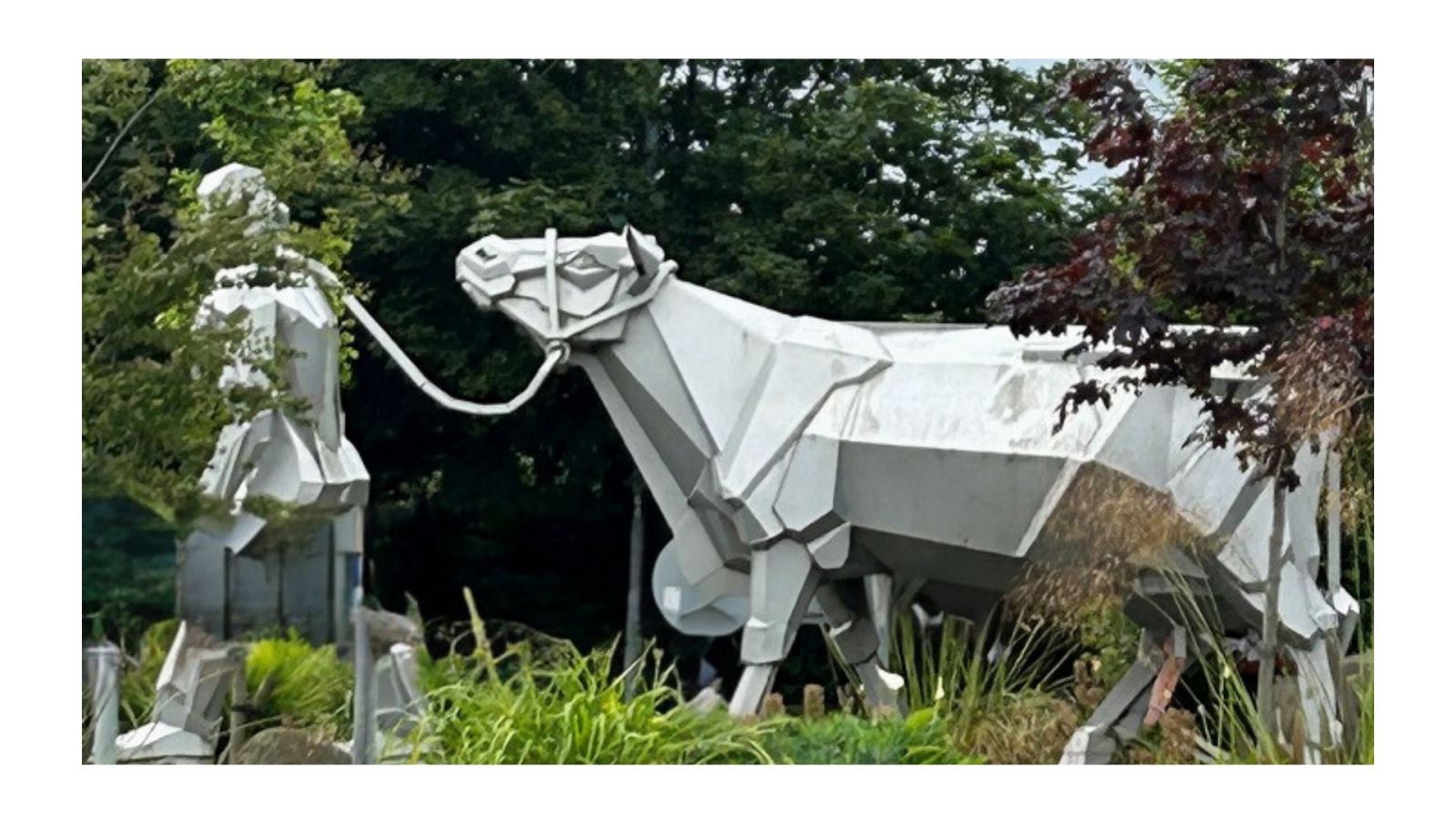
Fairs were held throughout Northern Ireland for over a hundred years, farmers would drive cattle to them from all quarters, and as well as trading, the fair was a means of socialising and an employment opportunity for many. The farmer driving his cattle was a common sight in Clough and the surrounding area, a sight that started to fade in the late forties due to improved roads and new modes of transport. The use of stainless steel brings a modern twist to this very traditional agricultural scene.
Dundrum
Dundrum, Main Street, Dundrum (opposite Tonn Ruary Café) - 'Sculptural Horn'
The trumpet represents the wave's mythical annunciating roar with a raised sculptural trumpet or horn. The mouth piece of the horn faces Main Street at eye level and the opposite side end flares out towards the bay.
The horn takes inspiration from the earliest trumpets indigenous to Ireland and is embellished with text and images chosen in collaboration with the local community and representative of life in Dundrum today. The trumpet also has a visual aspect that you can look through and see the framed bay through the sculptural scope and creates a visual link with Dundrum Bay.
Kilkeel
Kilkeel is the fishing capital of the Mournes and is home to Northern Ireland’s largest fishing fleet. As well as fishing, farming and granite are the predominant industries in Kilkeel. There are a number of pieces of public art throughout Kilkeel:
Narrows Journey - Mourne Esplanade, by Ned Jackson Smyth
Woman & Children - Greencastle Street, represents the many women and children who wave goodbye to family members as they leave for their fishing journey at sea.
Fisherman and Creel - Mourne Esplanade, represents a fisherman's skill and labour.
Fish Sculpture - Kilkeel Harbour, by Ian Patterson
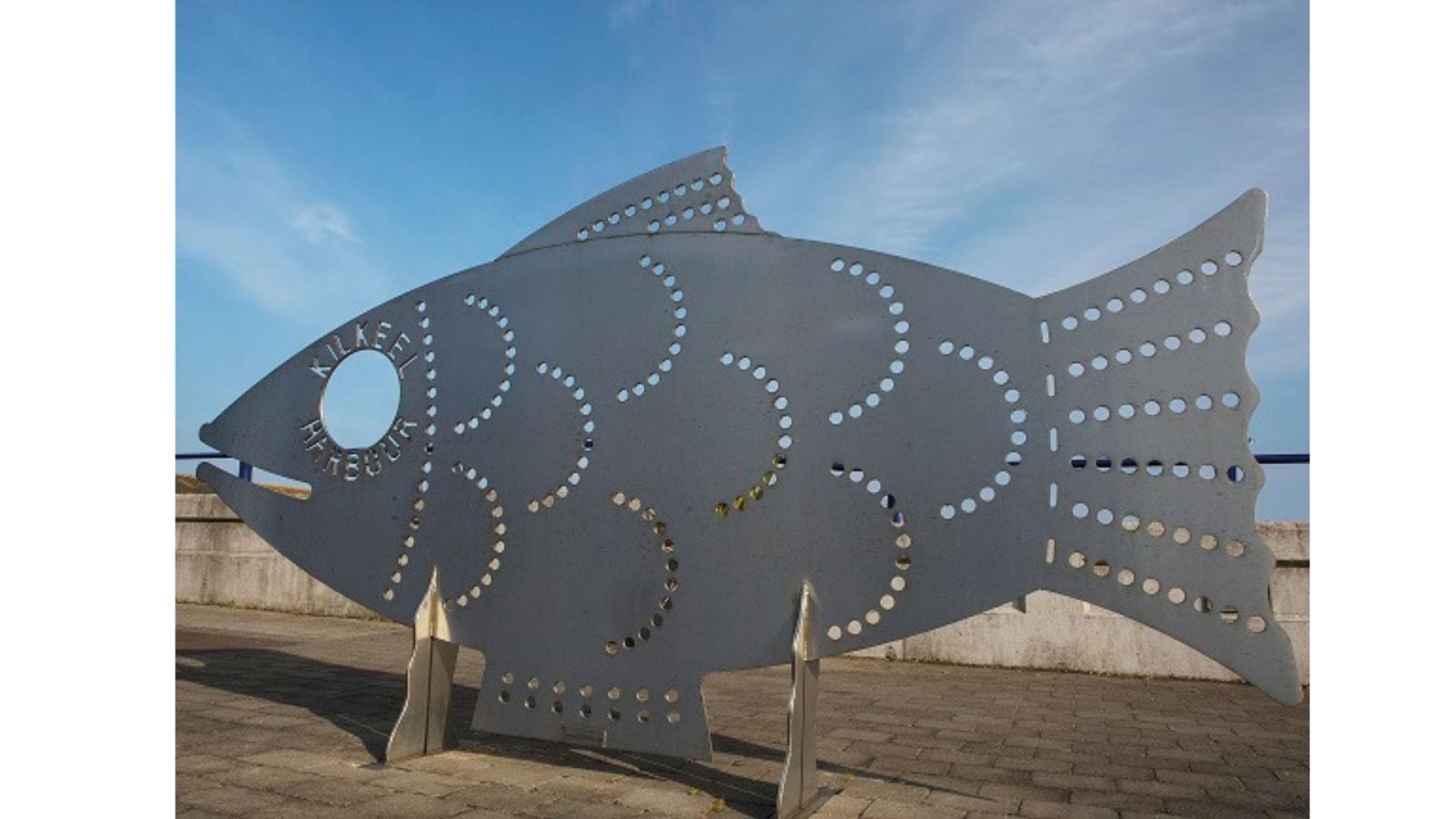
Our Town - Land and Sea, Greencastle Street, by Melanie Jackson
Each piece celebrates in its own way these connections to fishing farming and granite. Alongside some you will have a vista overlooking the Irish Sea where you can watch the fishing boats leaving and landing their catch. Mourne Granite, which is known to be the toughest stone in Europe, is used throughout.
Silent Valley Mountain Park, Head Road - `The Mourne Hand'
The inspiration for this piece has come from many resources. The Mourne granite bowl and wedge represent the reservoir and the dam. The Binnian Tunel is the 7ft arch - the same size as the actual tunnel. The other `trumpet like' forms announce the diversity of nature to be found around the Silent Valley, while the stalks are tributaries within the water catchment area. The Hand at the base is a reference to the men of Mourne that built the wall, dams and tunnel - whose children remember them having `broad shoulders and hands like shovels' - men of the land.
Meigh
Slieve Gullion Forest Park - `The Calliagh Beara'
This art feature follows the footsteps of the legendary Fionn MacCumhaill (or Finn McCool), of the Fianna warriors. Fionn walked up the slopes of Slieve Gullion to the lake near the summit to find a beautiful young lady sobbing on the water's edge. Being a gentleman he enquired as to why she was crying, to which she replied that she had dropped her golden ring in the bottomless like. Without a moment's hesitation, Fionn ripped of his shirt and dived in, swam down until he found the ring, grabbed it and returned to the top only to find an old hag (the Calliagh Berra) laughing. The witch had tricked Fionn and he crawled out on the lake's shore as an old, withered man. Fionn came down the mountain unrecognisable even to the Fianna ! However, when his trustworthy Irish Hound smelled the old man, he knew that he was their master. Fionn, the Fianna and the hounds forced the Calliagh Berra to restore Fionn to his youth, but it is said that his hair remained white, like an old man's, for the rest of hislife, and that his fate will befall anyone who bathes in the lake to this very day.
Strangford
Three pieces of public art in the form of village welcome features for the village of Strangford were commissioned by Down District Council in association with Strangford Community Association. Artist Billy McCaughern of Metal Imagineers was commissioned to design, manufacture and install the three art pieces. The entrance features were erected at each of the three main entrances to the village, the Shore Road, Downpatrick Road and the Ferry Terminal.
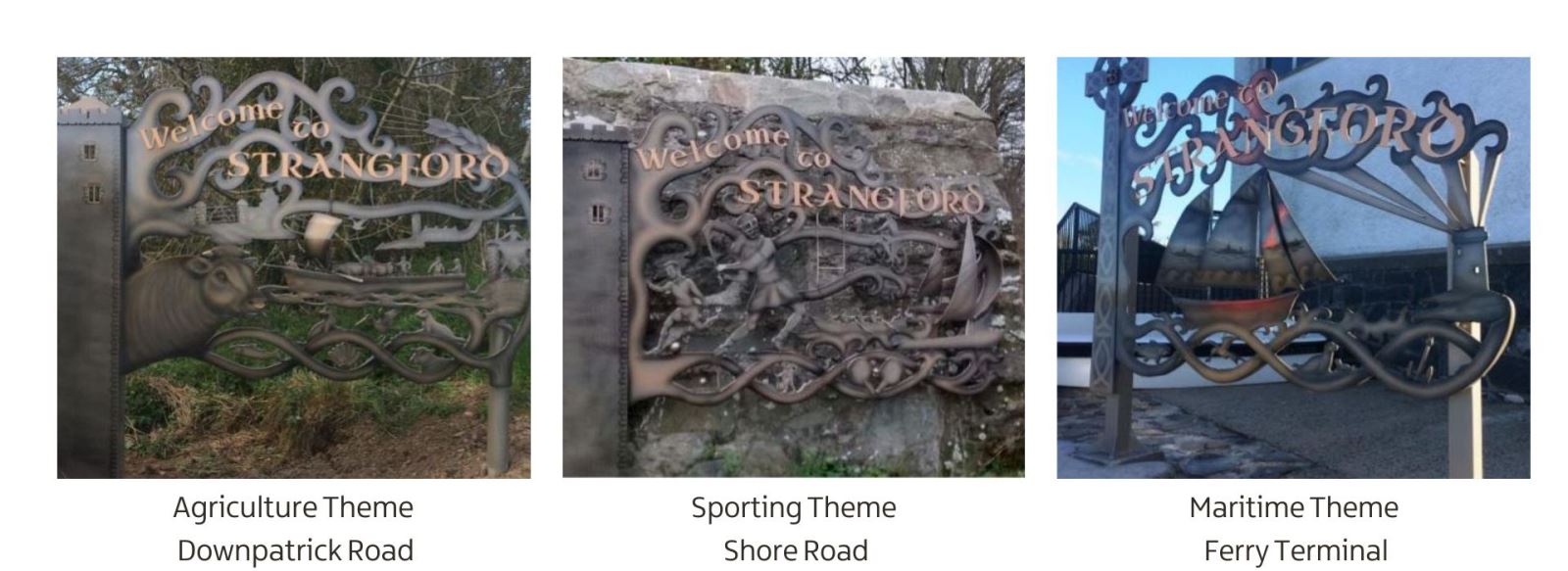
The art pieces were based around the themes of The Maritime history, Agriculture and Sport. The design of each was influenced by the local area with each one capturing an aspect of life in the village that was relevant to the local people with all three encompassing the wording `Welcome to Strangford'.
Warrenpoint
Warrenpoint Elk (Narrow Water Roundabout, A2 to Newry)
This life size (2.1m/6.9ft tall at the shoulders) sculpture of an Irish Elk (or giant deer). Megaloceros giganteus had the largest antlers of any known cervid; a max of 3.65m/12ft from tip to tip and weighing up to 40kgs/88lbs. The size of the antlers is distinctive, and several theories have arisen as to the evolution..jpg)
One theory was that their antlers increased in size because males used them in combat for females; it was also suggested that they became so unwieldy that the Irish Elk could not carry on the normal business of life and so became extinct. For the passing viewer, it is a reminder of evolution, time, and a reminder of an age when the wilderness of the land dominated the environment.
Camlough
Camlough, (At junction of A25 and Newtown Road)
The geometric 4m high piece of artwork expresses the dynamic energy and complexity of the natural water cycle, from cloud to the area’s great `Crooked Lake’, from river to mill pond and its eventual evaporation. The concept was taken from a children’s drawing at a community engagement workshop. The work uses a spectacular visual effect, created by shaping and layering stainless steel mesh info the form of an evolving cloud that represents the water cycle.
Downpatrick
The St Patrick's Centre, Market Street - Brooch
Penannular Brooches, with their distinctive gap in the hoop, were worn by both men and women as early as the 17th Century. The brooches were used to fasten cloaks and a real example can be seen in the Down County Museum. Created by artist Alan Burke, is a five metre high
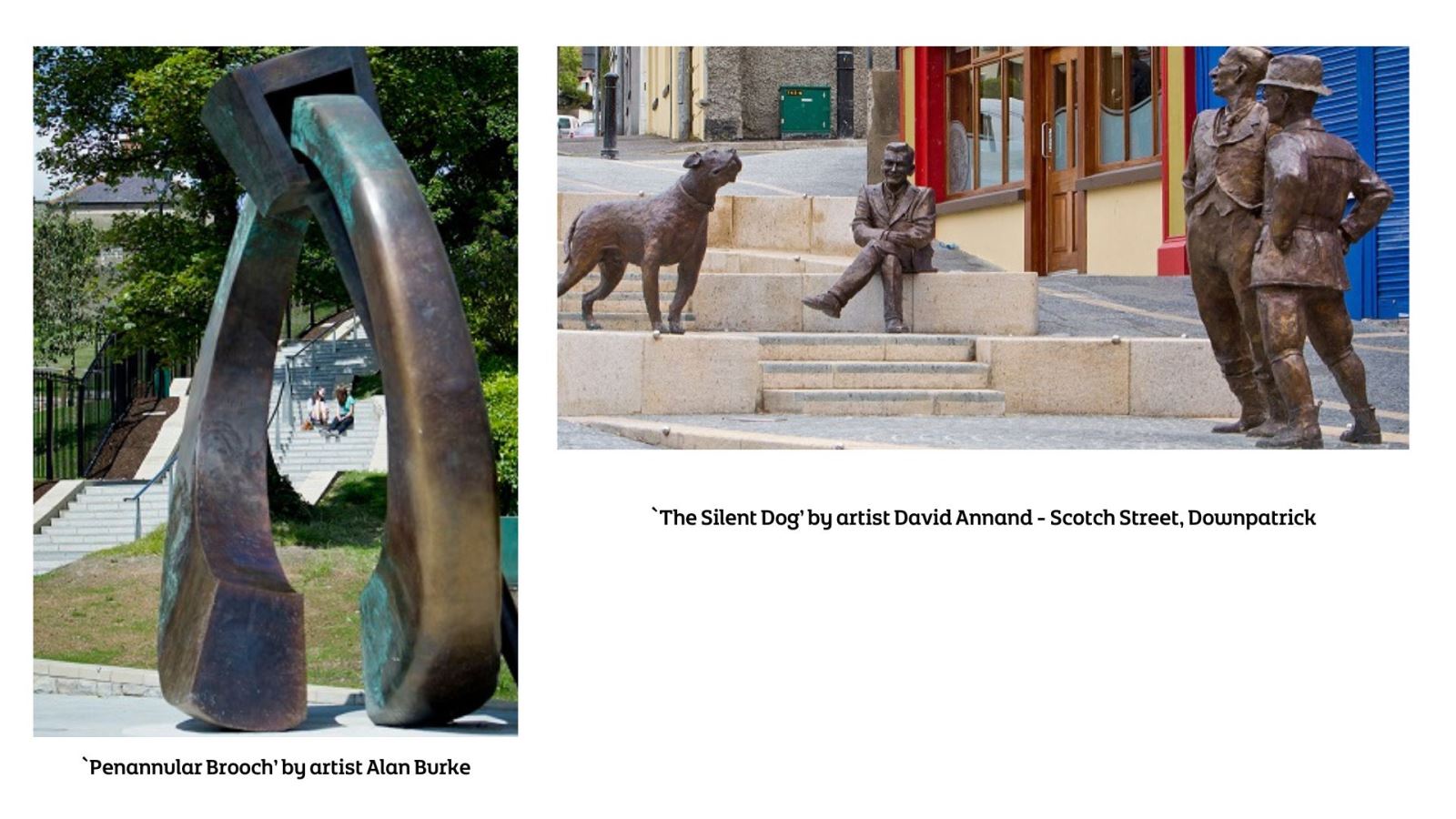
St Patrick's Journey, Belfast Road
This piece signals Downpatrick's importance in the Christian Heritage of the country and the Saint's important and factual associations with the town and its hinterland. he landed at Strangford, formed his first church at Saul and his remains purportedly lie in the grounds of Down Cathedral.
The Cross (Green area at Roughal Park)
This is a partially cross-shaped abstract shape on a tall pedestal. It has 4 sides with relief shapes and figures cast in different styles.
Newry
These three pieces of art which are located along Newry canal/quayside all celebrate Newry's past as a centre for trade. If you have a stroll from the Albert Basin to Sugar Island, you will come across all three pieces.
`Newry Navvy', by Barry Linnane
This piece seeks to honour the men who constructed the Newry Canal which was built in 1742 and was the first summit canal in the UK and Ireland. The original canal labourers were called navigators, later shortened to `Navys'.
.jpg)
`Newry Dockers', by Sculpture Studios/Tonny Stallard
This piece emphases the importance of the Docks. Many thousands of men were employed over generations as dockers and very notably as seamen and many ships were registered in the port.
`Trading Placs', by Chris Wilson
This piece celebrates the trading history of the City of Newry and especially the importance of the Newry Canal to its industrical development.
Kildare Street, Newry - Pat Jennings Statue
Created by the incredibly talented sculptor Andy Edwards, the statue for Northern Ireland goalkeeping legend Pat Jennings was unveiled in Newry City by Mr Jennings himself in October 2023.
The 'Friends of Big Pat' group in collaboration with Newry, Mourne and Down District Council, wanted to acknowledge the incredible talent of Pat Jennings and the group raised the funds required for the statue.
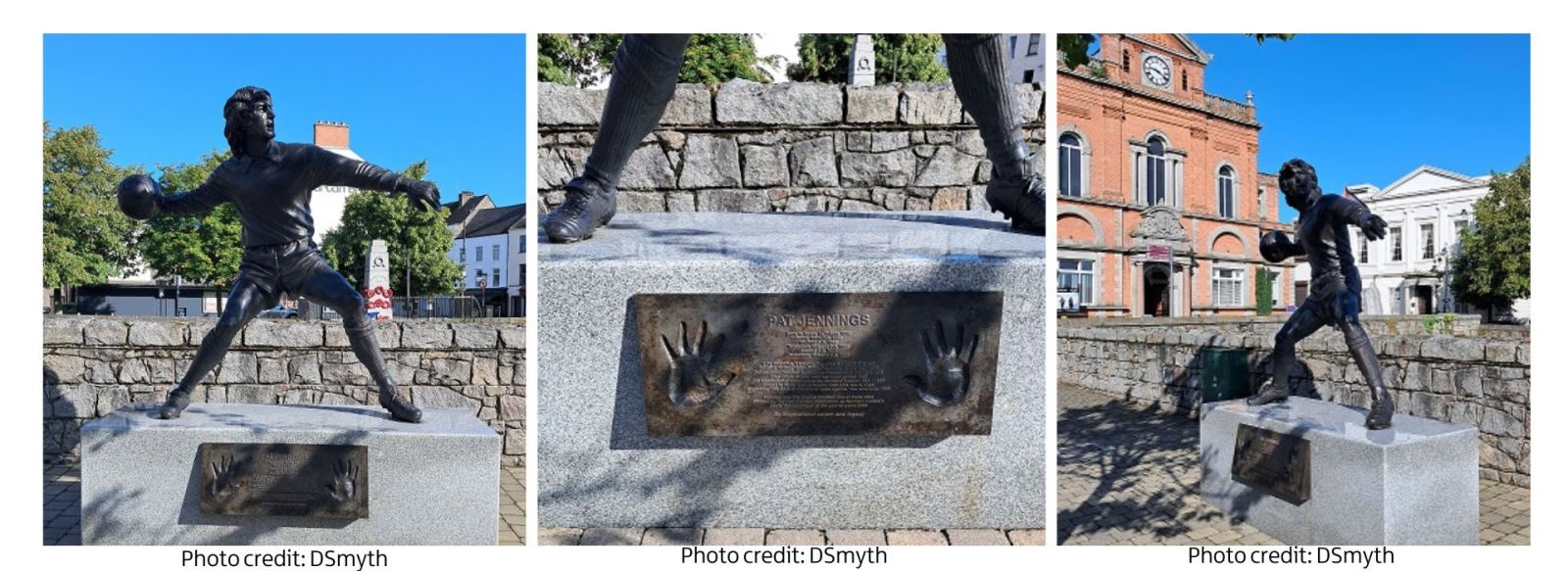
The bronze sculpture, which is almost three metres tall, sits on a granite plinth just opposite Newry Town Hall.
Pat Jennings has many times been referred to as the "best goal keeper in the world" so it is vey fitting that this staute has been unveiled in his homeplace of Newry City.









